An observational analysis of the impact of indoor residual spraying with non-pyrethroid insecticides on the incidence of malaria in Ségou Region, Mali: 2012-2015
- PMID: 29316917
- PMCID: PMC5761159
- DOI: 10.1186/s12936-017-2168-2
An observational analysis of the impact of indoor residual spraying with non-pyrethroid insecticides on the incidence of malaria in Ségou Region, Mali: 2012-2015
Abstract
Background: Ségou Region in Central Mali is an area of high malaria burden with seasonal transmission, high access to and use of long-lasting insecticidal nets (LLINs), and resistance to pyrethroids and DDT well documented in Anopheles gambiae s.l. (the principal vector of malaria in Mali). Ségou has recently received indoor residual spraying (IRS) supported by Mali's collaboration with the US President's Malaria Initiative/Africa Indoor Residual Spraying programme. From 2012 to 2015, two different non-pyrethroid insecticides: bendiocarb in 2012 and 2013 and pirimiphos-methyl in 2014 and 2015, were used for IRS in two districts. This report summarizes the results of observational analyses carried out to assess the impact of these IRS campaigns on malaria incidence rates reported through local and district health systems before and after spraying.
Methods: A series of retrospective time series analyses were performed on 1,382,202 rapid diagnostic test-confirmed cases of malaria reported by district routine health systems in Ségou Region from January 2012 to January 2016. Malaria testing, treatment, surveillance and reporting activities remained consistent across districts and years during the study period, as did LLIN access and use estimates as well as An. gambiae s.l. insecticide resistance patterns. Districts were stratified by IRS implementation status and all-age monthly incidence rates were calculated and compared across strata from 2012 to 2014. In 2015 a regional but variable scale-up of seasonal malaria chemoprevention complicated the region-wide analysis; however IRS operations were suspended in Bla District that year so a difference in differences approach was used to compare 2014 to 2015 changes in malaria incidence at the health facility level in children under 5-years-old from Bla relative to changes observed in Barouéli, where IRS operations were consistent.
Results: During 2012-2014, rapid reductions in malaria incidence were observed during the 6 months following each IRS campaign, though most of the reduction in cases (70% of the total) was concentrated in the first 2 months after each campaign was completed. Compared to non-IRS districts, in which normal seasonal patterns of malaria incidence were observed, an estimated 286,745 total fewer cases of all-age malaria were observed in IRS districts. The total cost of IRS in Ségou was around 9.68 million USD, or roughly 33.75 USD per case averted. Further analysis suggests that the timing of the 2012-2014 IRS campaigns (spraying in July and August) was well positioned to maximize public health impact. Suspension of IRS in Bla District after the 2014 campaign resulted in a 70% increase in under-5-years-old malaria incidence rates from 2014 to 2015, significantly greater (p = 0.0003) than the change reported from Barouéli District, where incidence rates remained the same.
Conclusions: From 2012 to 2015, the annual IRS campaigns in Ségou are associated with several hundred thousand fewer cases of malaria. This work supports the growing evidence that shows that IRS with non-pyrethroid insecticides is a wise public health investment in areas with documented pyrethroid resistance, high rates of LLIN coverage, and where house structures and population densities are appropriate. Additionally, this work highlights the utility of quality-assured and validated routine surveillance and well defined observational analyses to rapidly assess the impact of malaria control interventions in operational settings, helping to empower evidence-based decision making and to further grow the evidence base needed to better understand when and where to utilize new vector control tools as they become available.
Keywords: Indoor residual spraying; Malaria incidence; Mali; Next generation IRS; Observational analysis.
Figures
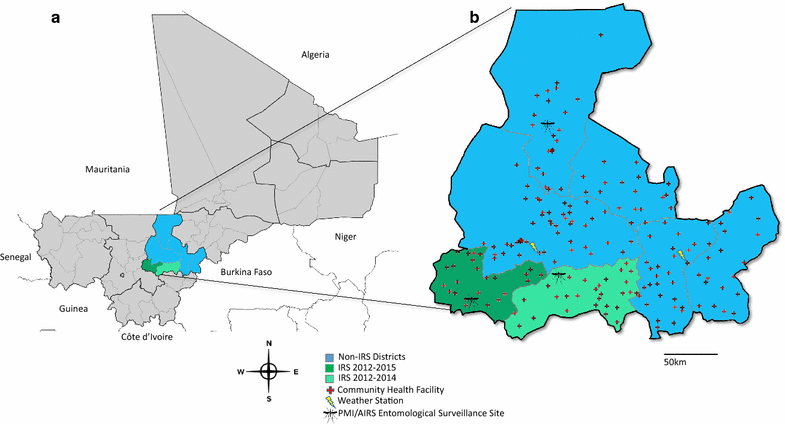
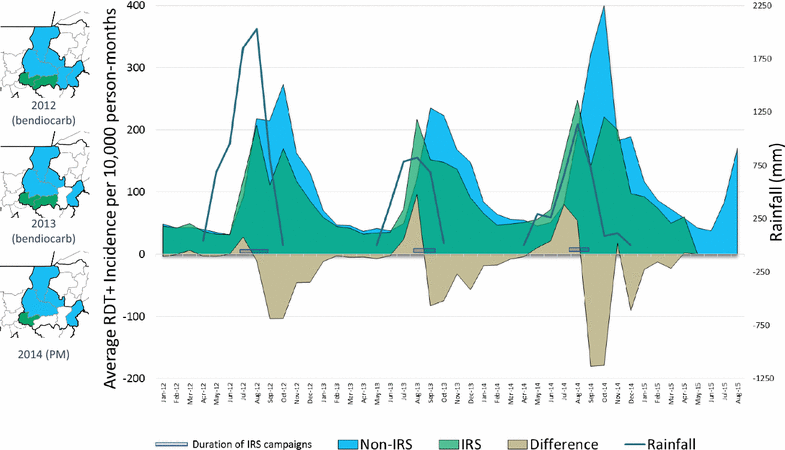
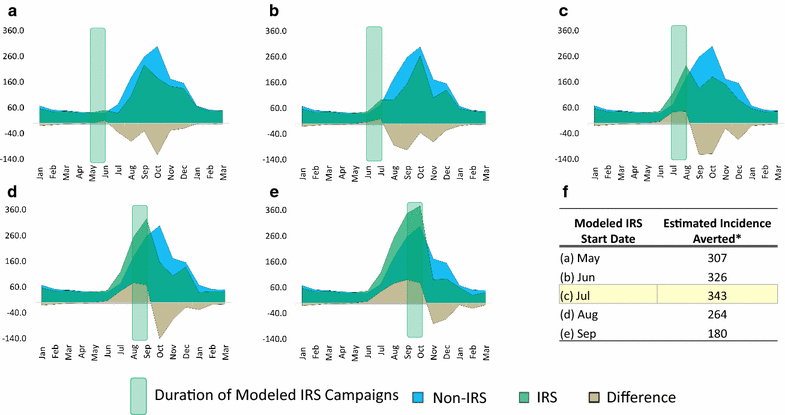
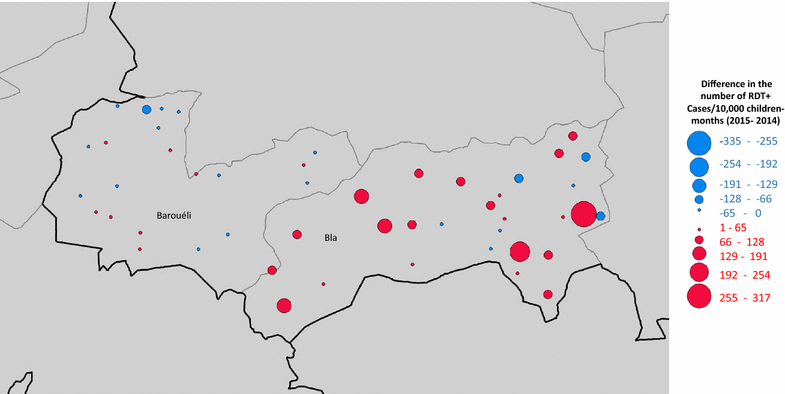
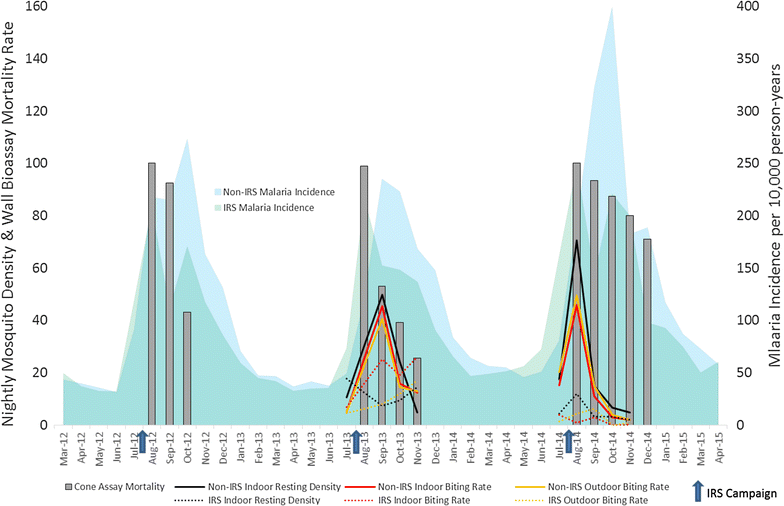
Similar articles
-
Combining next-generation indoor residual spraying and drug-based malaria control strategies: observational evidence of a combined effect in Mali.Malar J. 2020 Aug 15;19(1):293. doi: 10.1186/s12936-020-03361-y. Malar J. 2020. PMID: 32799873 Free PMC article.
-
Rapid reduction of malaria transmission following the introduction of indoor residual spraying in previously unsprayed districts: an observational analysis of Mopti Region, Mali, in 2017.Malar J. 2020 Sep 19;19(1):340. doi: 10.1186/s12936-020-03414-2. Malar J. 2020. PMID: 32950056 Free PMC article.
-
Reduced exposure to malaria vectors following indoor residual spraying of pirimiphos-methyl in a high-burden district of rural Mozambique with high ownership of long-lasting insecticidal nets: entomological surveillance results from a cluster-randomized trial.Malar J. 2021 Jan 21;20(1):54. doi: 10.1186/s12936-021-03583-8. Malar J. 2021. PMID: 33478533 Free PMC article. Clinical Trial.
-
Indoor residual spraying for preventing malaria in communities using insecticide-treated nets.Cochrane Database Syst Rev. 2019 May 23;5(5):CD012688. doi: 10.1002/14651858.CD012688.pub2. Cochrane Database Syst Rev. 2019. Update in: Cochrane Database Syst Rev. 2022 Jan 17;1:CD012688. doi: 10.1002/14651858.CD012688.pub3. PMID: 31120132 Free PMC article. Updated.
-
Malaria vector control in sub-Saharan Africa: complex trade-offs to combat the growing threat of insecticide resistance.Lancet Planet Health. 2024 Oct;8(10):e804-e812. doi: 10.1016/S2542-5196(24)00172-4. Lancet Planet Health. 2024. PMID: 39393381 Review.
Cited by
-
Measuring changes in Plasmodium falciparum census population size in response to sequential malaria control interventions.medRxiv [Preprint]. 2025 Jun 17:2023.05.18.23290210. doi: 10.1101/2023.05.18.23290210. medRxiv. 2025. PMID: 37292908 Free PMC article. Preprint.
-
Stratification at the health district level for targeting malaria control interventions in Mali.Sci Rep. 2022 May 18;12(1):8271. doi: 10.1038/s41598-022-11974-3. Sci Rep. 2022. PMID: 35585101 Free PMC article.
-
Long-lasting insecticidal nets provide protection against malaria for only a single year in Burundi, an African highland setting with marked malaria seasonality.BMJ Glob Health. 2022 Dec;7(12):e009674. doi: 10.1136/bmjgh-2022-009674. BMJ Glob Health. 2022. PMID: 36455989 Free PMC article.
-
Indoor residual spray bio-efficacy and residual activity of a clothianidin-based formulation (SumiShield® 50WG) provides long persistence on various wall surfaces for malaria control in the Democratic Republic of the Congo.Malar J. 2019 Mar 12;18(1):72. doi: 10.1186/s12936-019-2710-5. Malar J. 2019. PMID: 30866934 Free PMC article.
-
An observational analysis of the impact of indoor residual spraying in Northern, Upper East, and Upper West Regions of Ghana: 2014 through 2017.Malar J. 2020 Jul 11;19(1):242. doi: 10.1186/s12936-020-03318-1. Malar J. 2020. PMID: 32652994 Free PMC article.
References
-
- WHO . World malaria report 2015. Geneva: World Health Organization; 2015.
-
- PMI. The President’s Malaria Initiative Tenth Annual Report to Congress. Washington, DC: US Agency for International Development; 2016. https://www.pmi.gov/docs/default-source/default-document-library/pmi-rep.... Accessed May 2016.
-
- PMI. The PMI Africa IRS (AIRS) Project Indoor Residual Spraying (IRS 2) task order six: Mali: malaria operational plan FY 2016. Bethesda: AIRS Project, Abt Associates Inc.; 2015. https://www.pmi.gov/docs/default-source/default-document-library/malaria.... Accessed Apr 2016.
-
- Global Burden of Disease Study 2016. Global burden of disease 2016 (GBD 2016) results. Seattle: Institute fo Health Metrics and Evaluation; 2016. http://vizhub.healthdata.org/gbd-compare/. Accessed Dec 2017.
Publication types
MeSH terms
Substances
Grants and funding
LinkOut - more resources
Full Text Sources
Other Literature Sources
Medical
Miscellaneous

